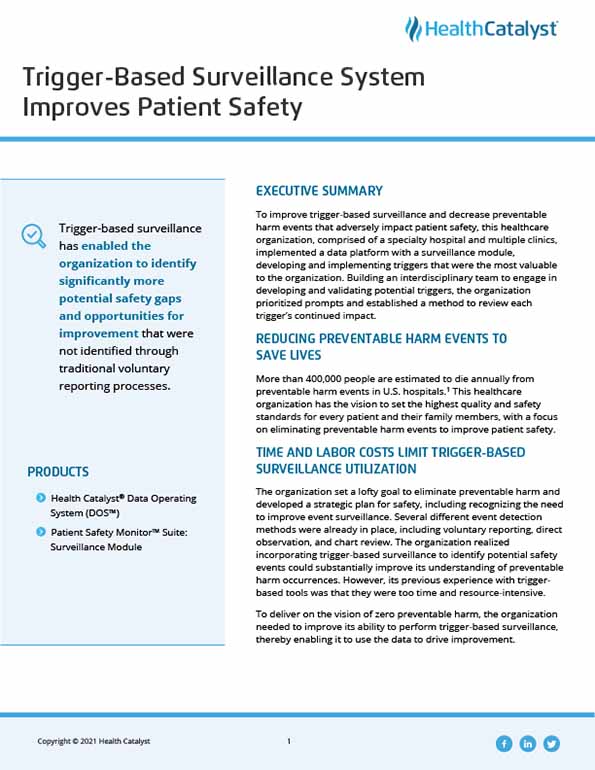To improve trigger-based surveillance and decrease preventable harm events that adversely impact patient safety, this healthcare organization, comprised of a specialty hospital and multiple clinics, implemented a data platform with a surveillance module, developing and implementing triggers that were the most valuable to the organization. Building an interdisciplinary team to engage in developing and validating potential triggers, the organization prioritized prompts and established a method to review each trigger’s continued impact.
More than 400,000 people are estimated to die annually from preventable harm events in U.S. hospitals.1 This healthcare organization has the vision to set the highest quality and safety standards for every patient and their family members, with a focus on eliminating preventable harm events to improve patient safety.
The organization set a lofty goal to eliminate preventable harm and developed a strategic plan for safety, including recognizing the need to improve event surveillance. Several different event detection methods were already in place, including voluntary reporting, direct observation, and chart review. The organization realized incorporating trigger-based surveillance to identify potential safety events could substantially improve its understanding of preventable harm occurrences. However, its previous experience with trigger-based tools was that they were too time and resource-intensive.
To deliver on the vision of zero preventable harm, the organization needed to improve its ability to perform trigger-based surveillance, thereby enabling it to use the data to drive improvement.
To improve trigger-based surveillance, the organization implemented the Health Catalyst® Data Operating System (DOS™) and a robust suite of analytics applications, including the Patient Safety Monitor™ Suite: Surveillance Module, partnering with Health Catalyst to develop and implement triggers that were most valuable to the organization.
The Surveillance Module is a trigger-based surveillance system, including predictive analytic models and AI. The analytics application uses data to quickly identify patterns of harm, enabling the opportunity to recognize and implement strategies that eliminate patient safety risks and hazards for current and future patients.
To begin, the organization prioritized developing and implementing specific triggers, selecting triggers aligned with organizational improvement goals. It also recognized the need to mindfully develop and build its use of triggers incrementally.
An interdisciplinary team is engaged in developing and validating potential triggers. Nurses, physicians, and pharmacists collaborate to identify the best sources of data for each trigger, understand the workflow, and pinpoint potential safety issues and failure points. This team participates in each trigger validation, ensuring they meet the desired predictive value, thereby reducing “noise” from false alerts.
The organization also established a process for reviewing triggers on a regular basis, retiring ones that are no longer needed, and refining those prompts in use to continually improve trigger accuracy. Using the analytics application, leaders and reviewers can view aggregated positive triggers by category, location, time period, service line, unit, individual triggers, and custom groups. They can create worklists for patient list review, assignment, assessment, and reporting.
A trigger prompts a reviewer to conduct further investigation. Designated, trained reviewers use patient detail data in the analytics application to determine if an adverse event has occurred, classify and document the event, and assign the event for further follow-up.
The organization can easily create and export patient safety data reports and can view positive triggers and adverse event metric visualizations over time, identifying opportunities for improvement.
Using a data-driven approach, the organization has successfully developed and implemented multiple patient safety triggers, including triggers to identify:
Trigger-based surveillance has enabled the organization to identify potential safety gaps and opportunities for improvement that were not recognized through traditional voluntary reporting processes. For example, the DVT trigger identified cases of missed DVT. The wrong patient order trigger identified eight times more near-miss prescribing events than reported as part of the voluntary reporting process.
The organization has leveraged data from the triggers to implement new process improvement activities, including a process for rapid response and code blue event reviews. The analytics application has improved efficiency, enabling the scalable use of triggers to eliminate preventable harm.
"Robust patient safety event detection using a variety of methods, including triggers is critical to have complete awareness of patient safety risks and opportunities for improvement."
- Chief Patient Safety Officer
The organization plans to expand its use of trigger-based surveillance and will continue to pursue its goal to eliminate preventable harm.


